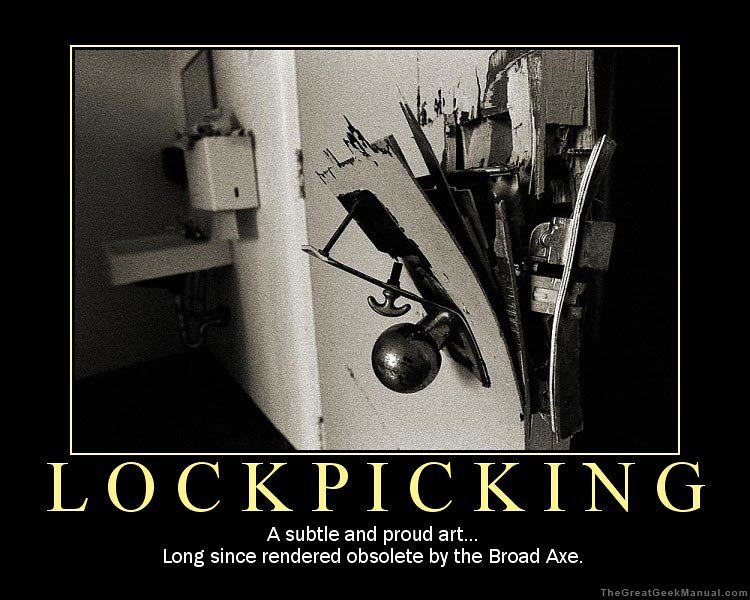Picture this: a skilled thief sneaking into a dimly lit room, armed not with a high-tech gadget or a complex contraption, but with a simple set of tools that fit in the palm of their hand. In their quest to gain access to tightly guarded secrets, they delicately manipulate a few metal objects, employing their wit, finesse, and a pinch of audacity. What key element allows these crafty infiltrators to unlock even the most impenetrable doors? The answer lies within a seemingly humble component known as the pin. In the intricate art of lock picking, pins play an indispensable role, quietly dictating the fate of a locked mechanism. In this detailed analysis, we will embark on a journey deep into the world of lock picking, dissecting the pivotal part that pins play, unraveling their secrets, and shedding light on the mesmerizing dance between locksmiths, thieves, and these extraordinary little masters of security.
Table of Contents
- Introduction: Understanding the Fundamentals of Lock Picking
- The Anatomy of Pins: Unveiling their Crucial Role in Lock Mechanisms
- Pin Variations: Analyzing the Key Factors for Successful Lock Picking
- Pin Manipulation Techniques: Unlocking the Secrets of Efficient Lock Picking
- Mastering the Art: Recommendations for Enhancing Lock Picking Skills
- Q&A
- The Way Forward

Introduction: Understanding the Fundamentals of Lock Picking
Lock picking is an ancient skill that has captured the imagination of both professionals and hobbyists alike. Often associated with burglary and illicit activities, lock picking is actually an art form that requires a deep understanding of mechanics and a delicate touch. This introductory guide aims to shed light on the fundamentals of lock picking, demystifying it and paving the way for exploration into this fascinating world.
At its core, lock picking is the practice of manipulating the components of a lock to gain entry without using the original key. It requires a combination of knowledge, dexterity, and patience. While it may seem daunting at first, mastering lock picking can open doors to a whole new realm of understanding the mechanisms that safeguard our possessions.
Understanding the basics of locks is crucial for any aspiring lock picker. Locks consist of various components, including the keyway, plug, pins, springs, and driver pins. Each element plays a vital role in the lock’s functioning, and comprehending how they interact is key to successfully picking a lock. Additionally, various tools are employed in lock picking, such as tension wrenches and lock picks, each serving a specific purpose in manipulating the lock’s components.
- Remember, lock picking should only be practiced ethically and legally.
- Lock picking is a valuable skill that can be used in locksmithing, security testing, and even as a recreational hobby.
- The art of lock picking requires practice, patience, and a dedication to understanding the intricacies of different lock types.
- Always ensure you have permission to pick a lock and never attempt to pick locks that you rely on for security.

The Anatomy of Pins: Unveiling their Crucial Role in Lock Mechanisms
When it comes to understanding lock mechanisms, an essential element that warrants a closer look is the humble pin. Acting as the unsung hero of security, pins are the tiny components that make up the intricate web of a lock’s anatomy. So, let’s enter the fascinating world of pins and unravel the secrets behind their crucial role.
1. The Key Allies: Pins work closely with the key to protect our belongings. They create an intricate puzzle that must be solved by the key’s unique ridges and valleys, aligning perfectly within the lock cylinder. As the key turns, the pins are maneuvered, elevating to precisely the right height to allow the lock to open.
2. Pin Varieties: Pins come in different shapes and sizes, varying based on their position within the lock. The most common types are driver pins and key pins. The former, positioned atop the latter, come in a variety of heights to secure the lock while still allowing it to be opened when the correct key is inserted.
3. Tolerances and Precision: The art of pin manufacturing lies in precision, with even the smallest deviation having a significant impact on a lock’s functionality. The manufacturing process involves careful calibration to ensure that the pins operate within the lock’s tight tolerances, guaranteeing the right balance of security and ease of use.
Understanding the anatomy of pins not only deepens our appreciation for the complexity of lock mechanisms but also sheds light on the importance of quality and precision in their manufacturing. Next time you unlock a door, spare a thought for the tiny pins secretly working behind the scenes to keep your belongings safe and secure.

Pin Variations: Analyzing the Key Factors for Successful Lock Picking
When it comes to lock picking, understanding pin variations is essential for any aspiring locksmith or hobbyist. These small, seemingly insignificant components can have a significant impact on the overall difficulty and success rate of picking a lock. By analyzing the key factors that influence pin variations, we can gain valuable insights into the art and science of lock picking.
Here are some key factors to consider when assessing pin variations:
- Pin Length: The length of a pin is crucial, as it determines the depth to which the pin needs to be pushed in order to unlock the mechanism.
- Pin Diameter: The diameter of a pin affects its overall size and fit within the lock cylinder. Pins with larger diameters typically require more precision and finesse to manipulate.
- Pin Material: The material from which the pin is made can significantly impact its durability and resistance to manipulation. Higher-quality locks often feature pins made from hardened steel or other robust materials.
By carefully considering these pin variations, lock pickers can fine-tune their techniques and increase their chances of successfully picking a lock. Remember, practice and patience are key, and understanding the intricacies of pin variations will undoubtedly contribute to your skill as a lock picker.
Pin Manipulation Techniques: Unlocking the Secrets of Efficient Lock Picking
Unlocking locks may appear as a daunting task, but with the right pin manipulation techniques, it can be a masterful art. These techniques are designed to give you the upper hand in efficiently picking locks, allowing you to gain access quickly and discreetly.
1. Single Pin Picking:
This technique involves identifying and manipulating individual pins within the lock cylinder. By using a tension wrench to apply slight torque and a pick to gently lift each pin, the pins can be manipulated to create a sheer line, eventually unlocking the lock.
2. Raking:
Raking is a more aggressive technique used to quickly open locks. It involves using a rake pick to rapidly move all the pins inside the lock cylinder. This continuous motion relies on the assumption that at least one combination of pin heights will align with the sheer line, resulting in the lock unlocking.
3. Bump Key Method:
Harnessing the concept of key bumping, this technique involves using specially crafted bump keys that exploit the mechanical nature of pin tumbler locks. By applying downward pressure on the bump key and striking it, the kinetic energy transfers to the pins, causing them to temporarily separate and allowing for quick lock opening.
With these intricate pin manipulation techniques at your disposal, the once mysterious world of lock picking becomes an exciting exploration. Remember, ethical use is of utmost importance, and these techniques should only be practiced with permission and the intent of enhancing security knowledge.
Mastering the Art: Recommendations for Enhancing Lock Picking Skills
Unlocking the secrets of lock picking requires practice, patience, and expertise. Here are some recommendations to help you improve your skills and become a master locksmith:
- Invest in quality tools: A skilled lock picker understands the importance of using the right tools. Choose high-quality lock picks, tension wrenches, and rakes to ensure precision and durability in your practice sessions.
- Study the anatomy of locks: To truly excel in lock picking, it is crucial to understand how locks work. Explore the different types of locks, study their components, and gain a deep knowledge of their mechanisms. This understanding will enable you to identify vulnerabilities and master the art of manipulation.
- Practice regularly: Like any skill, regular practice is key to improving your lock picking prowess. Dedicate time to honing your skills, starting with simple locks and gradually progressing to more complex ones. Challenge yourself with various lock picking techniques and strive for consistency and precision.
- Educate yourself: Lock picking is a vast field, and continual learning is vital to stay ahead. Engage with the lock picking community, attend workshops, and participate in forums to exchange tips, tricks, and insights with fellow enthusiasts. Expand your knowledge, experiment with new techniques, and push the boundaries of your abilities.
Remember, lock picking should only be used responsibly and ethically. These recommendations aim to assist enthusiasts in mastering the technique, arming them with the knowledge and skills needed to navigate this intriguing world.
Q&A
1. How do pins play a crucial role in lock picking?
Pins are fundamental components of a lock mechanism, and their precise configuration determines the complexity of lock picking. By manipulating the position and alignment of pins, a skilled lock picker can achieve the delicate balance required to unlock the mechanism.
2. Are all pins in a lock identical?
No, in fact, most locks have varying pin sizes and lengths. Manufacturers strategically design locks with different pin configurations to enhance security levels, adding an extra layer of complexity to lock picking.
3. Can the number of pins in a lock affect lock picking difficulty?
Absolutely! A lock with more pins generally increases the difficulty of picking. Each additional pin requires additional manipulation to align correctly, making it more challenging for a would-be intruder to swiftly unlock the mechanism.
4. Are there any specialized tools used to manipulate pins in lock picking?
Yes, locksmiths and lock pickers utilize an array of specialized tools such as picks, hooks, and tension wrenches. These tools allow them to effectively manipulate the pins within a lock to unlock it.
5. How do multiple sets of pins impact lock picking?
Locks with multiple sets of pins, such as those found in high-security locks, significantly increase the complexity of lock picking. Each set of pins must be precisely aligned, requiring exceptional skill and patience from the individual attempting to pick the lock.
6. Can the shape of pins influence lock picking?
Certainly! Locks can feature a variety of pin shapes, such as spooled or serrated pins. These unique pin shapes serve to further enhance security by creating additional obstacles for lock pickers, making the unlocking process more challenging.
7. Is it possible to pick a lock without manipulating the pins?
While rare, there are alternative lock picking techniques that do not primarily involve manipulating pins. These methods may include bypassing the lock mechanism entirely or exploiting other vulnerabilities in the lock design.
8. Can the role of pins be considered both a blessing and a curse in lock picking?
Indeed! The complex interplay of pins presents both sides of the coin. For locksmiths, it is a blessing as they design secure locks, but for lock pickers, it can be seen as a curse as they navigate the intricacies of picking to overcome these security measures.
The Way Forward
In conclusion, as we have delved into the captivating world of lock picking, we have unraveled the shimmering secrets hidden within the intricate mechanism of locks. Through our meticulous analysis, we have shed light on the paramount role that pins play in this enigmatic art form.
Like the elusive dancers in a clandestine ballet, the pins gracefully pirouette, their delicate movements orchestrating the delicate harmony that separates the lock from its secrets. Each pin, from the steadfast driver pin to the mischievous driver pin, possess their distinctive personality, contributing to the symphony of security or vulnerability.
While lock picking has unfortunately garnered a reputation as a skill of nefarious intentions, we must remember that understanding the mechanics of locks empowers us in securing our own abodes. By grasping the art of picking, we grasp the art of protection, and the importance of robust lock designs that stand as guardians against unwelcome intrusions.
It is imperative, however, that we approach this knowledge with prudence and ethical responsibility, as with great power comes immense accountability. Just as a skilled physician uses their expertise for the betterment of humanity, a proficient locksmith can employ their understanding of lock picking to fortify security measures against criminals.
As we bid farewell to this profound exploration, let us acknowledge the intricate beauty ingrained in the humble pins that guard our safety. May our newfound knowledge fuel a greater appreciation for the craftsmanship that designers invest when creating locks, and the diligence required to overcome their formidable defenses.
Lock picking is a captivating dance of skill, artistry, and technicality—it unveils the hidden tales woven between the threads of security and vulnerability. So, as we venture forth with newfound wisdom, may we forever look upon locks with awe, respecting their impenetrable nature, yet daring to uncover the secrets they hold within.
As an affiliate, my content may feature links to products I personally use and recommend. By taking action, like subscribing or making a purchase, you’ll be supporting my work and fueling my taco cravings at the same time. Win-win, right?
Want to read more? Check out our Affiliate Disclosure page.